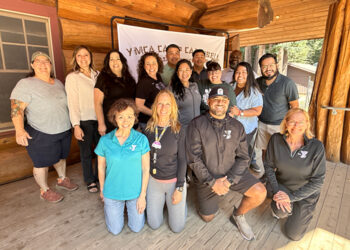Anxiety and depression in fitness – suggestions for how leadership staff can support the mental health of their employees and members. Coauthored by Ethan Smoorenburg and Sean Polidore.
It is a normal part of life to experience occasional anxiety or feel low and sad at times. It is when these feelings are persistent, seemingly uncontrollable, overwhelming and interferes with our daily lives, that anxiety and depression can be disabling.
Mental health has been and continues to be stigmatized. In recent years there has been more openness towards “being ok with not being ok,” and it is in our best interest to continue to motivate awareness and actions for healing. The heaviness of the crises we have all been faced with recently has left an impact on our well-being.
Anxiety and depression can be viewed as the most well-known mental disorders. According to the Anxiety and Depression Association of America, 18.1% of the U.S. population is affected by anxiety disorders every year and many of those who struggle also have a co-occurring disorder or physical illness.
Depression is also the leading cause of disability in the United States among peoples ages 15-44, and nearly half of those diagnosed with depression are also diagnosed with an anxiety disorder. Fitness and movement are shown to combat the adverse effects of anxiety and depression, however, 63% of those who struggle, do not receive treatment, an unfortunate statistic, as these disorders are in fact highly treatable.
If as a society we feel apprehensive to improving our struggles with mental health, and specifically, anxiety and depression, how can we be mindful of the mental well-being of ourselves, members and staff in our facilities?
I had the great pleasure of teaming up with Sean Polidore, MS, Professor of Psychology at South Louisiana Community College, and NASM certified personal trainer, to gain his perspective on this matter.
Below, I share my conversation with Sean who offered insightful suggestions for how leadership staff can support the mental health of their employees and members:
What behaviors are signs that staff and/or members may be struggling with anxiety and depression.
- Excessive comments being made about hurting themselves, someone else or other things.
- Constantly celebrating conflict.
- A person’s joy appearing diminished and having a noticeable change/shift in demeanor.
- More frequent physical ailments and reduced energy.
What are the best practices to take if a member shares they struggle with anxiety or depression?
Acknowledge it is ok to talk to someone. Be empathetic and provide a safe space so it is known that you are part of their team.
Reset your time if needed. It is ok in this case to talk instead of train. Make sure to find a quiet space, listen with empathy and schedule the next session before they leave.
Remain in the scope of practice of trainer or coach. Follow up with a call the next day to check-in and continue to stay connected often with a “pulse check” on how they are feeling.
Suggest speaking to a counselor or therapist if behaviors are occurring that cause uncertainty towards what should be done to best support the person.
How can leaders best communicate with a staff member whose work performance is struggling because of anxiety or depression?
Have a “hats off conversation.” It is suggested for the leader to humanize themselves with personal lightness and perhaps bring up a past struggle of their own to get on each other’s level. The use of body language, such as leaning in, eye contact and not interrupting or multi-tasking helps the staff member to feel heard.
First, identify and affirm what the staff member is great at, and acknowledge their struggle rather than immediately reprimanding them.
Simplify the course for improvement for their well-being and empathize. Make it known to not confuse busyness with efficiency. Offer clarity for the staff member to understand what is required for them to be successful in their role. Be specific and share why improvement is important for the situation at hand and dig deep to learn more about why the person you are speaking with is struggling. Do not be afraid to ask what you can do better also.
What practical actions can be suggested to help staff and members who struggle with anxiety and depression?
It is suggested for those who struggle to solidify daily habits that will prime themselves to cope positively with their greatest stresses. Here are examples of habits that help acknowledge emotions with mindfulness:
- Take two to three minutes to breathe between daily tasks if you know you may feel overwhelmed with back-to-back items on your schedule. Manage your transitions.
- Take breath work a step further by performing a body scan. Get comfortable (laying down or sitting) with your eyes closed and focus on your breath and what you are experiencing head to toe. Discover what is really felt in the present moment as to not suppress anything.
- Journal at the end of the day to reflect on what went well and what could have gone better. Use this as an opportunity to learn, feel and set intentions for the next day.
Also, empower those who struggle to take time to rest and recover. Encourage them to manage their energy bank account. Be someone they feel they can reach out to when they need a listening ear.
How can we form fitness environments that are inclusive for those who struggle with anxiety and depression?
Create communities where people feel understood. Introduce people to others who have similar thoughts or struggles (with their permission), and create a culture where members get to share experiences together with staff members, in groups and/or through fun events.
Show members that you care about their whole self and not just within the four walls of the facility.
Also, Cleanliness = Trust now more than ever. Put people’s minds at ease by speaking about your cleaning and sanitizing processes and make sure they have easy access to cleaning supplies.
What additional wisdom can be given to help those who struggle with anxiety and depression?
Use visualization of a desired outcomes as a source for motivation for others to anticipate what it will feel like to overcome their struggles at a pace that is suitable for them.
While movement is indeed medicine, it is suggested to not put people in a box when it comes to improving their health. Get creative and provide options that are best suited for the individual and their struggles. Personalization is key.
Get people curious to learn a new skill or hobby and feel in control of their processes.
Suggest avoiding negative content on social media or the news so their reality is not further skewed.
Sean’s suggested online and phone resources for help with anxiety and depression:
- 24 Hour Anxiety Disorder Helpline > mentalhelp.net
- Online Depression Chat Rooms > verywellmind.com
- National Suicide Prevention Lifeline > 800.273.8255










